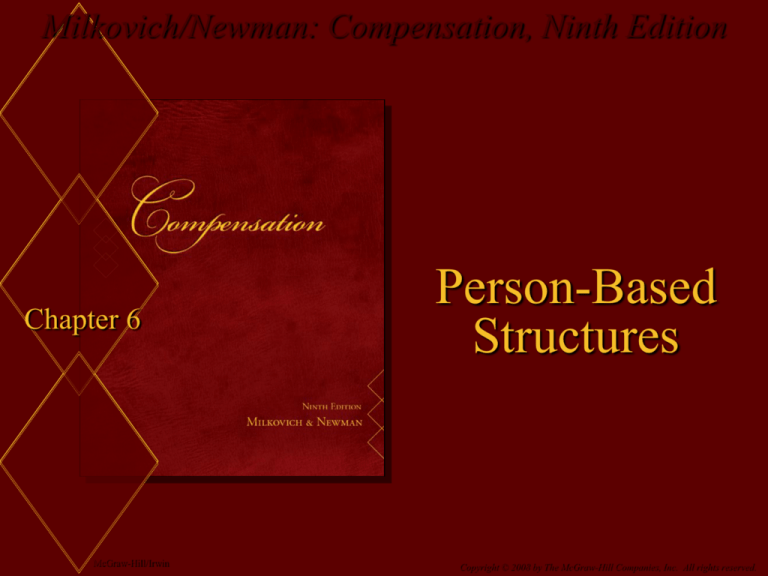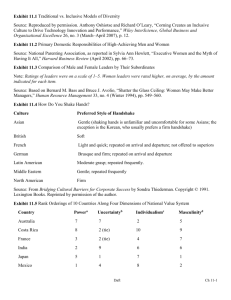
Milkovich/Newman: Compensation, Ninth Edition
Chapter 6
McGraw-Hill/Irwin
Person-Based
Structures
Copyright © 2008 by The McGraw-Hill Companies, Inc. All rights reserved.
Exhibit 6.1: Many Ways to Create Internal Structure
6-2
Person-Based Structures: Skill Plans
Advantage of a skill-based plan is that people
can be deployed in a way that better matches the
flow of work
6-3
What is a Skill-Based Structure?
Skill-based structures link pay to the
depth or breadth of the skills, abilities,
and knowledge persons acquire that are
relevant to the work.
In contrast, a job-based plan pays
employees for the job to which they are
assigned, regardless of the skills they
possess.
6-4
Types of Skill Plans
Skill plans can focus on
– Depth based
Specialist
– Breadth based:
Generalist/ multiskilled based
6-5
Purpose of the Skill-Based Structure
Supports strategy and objectives
Supports work flow
Fair to employees
Motivates behavior toward
organization objectives
6-6
Exhibit 6.3: Determining the
Internal Skill-Based Structure
6-7
“How To” – Skill Analysis
To build a structure, a process is needed to
describe, certify, and value the skills
What information to collect? (Exhibit 6.4:
FMC’s Technician Skill-Based Structure)
– Foundation skills
– Core electives
– Optional electives
Whom to involve?
– Employees and managers
Establish certification methods
– Peer review, on-the-job demonstrations, or tests, or
formal tests
6-8
Exhibit 6.4: FMC’s Technician Skill-Based Structure
6-9
“How To” – Skill Analysis (cont.)
Guidance from the research on skill-based plans
– Design of certification process crucial in perception
of fairness
– Alignment with organization’s strategy
– May be best for short-term initiatives
6-10
How is SBP Different From Job-Based?
Skills or skill units are compensable, rather than
jobs (although note that job-based pay does
typically involve skill as compensable factor)
Mastery of skill blocks measured and certified
Pay changes don’t necessarily accompany job
changes
Little emphasis placed on seniority in pay
determination
6-11
Potential Effects of Skill-Based System
Higher productivity
Lower costs (???)
Higher quality
Lower staffing levels
Lower absenteeism
Lower turnover
Improved relations with labor union
6-12
Disadvantages of Skill-Based Pay
Average pay of Ees likely higher
High labor costs, IF productivity increases do
not offset additional costs
SBP systems more complex
SBP systems require major investment in
training
6-13
Person-Based Structures: Competencies
Several perspectives on what competencies are
and what they are meant to accomplish
– Skill that can be learned and developed or a trait that
includes attitudes and motives?
– Focus on the minimum requirements that the
organization needs to stay in business or focus on
outstanding performance?
6-14
Exhibit 6.5: Determining the Internal
Competency-Based Structure
6-15
Terms in Competency Analysis
Core competencies
– Related to mission statements expressing
organization’s philosophy, values, business
strategies, and plans
Competency sets
– Translate each core competency into action
Competency indicators
– Observable behaviors that indicate the level of
competency within each set
6-16
Competency-Based Approaches
Exhibit 6.6: TRW Human Resources
Competencies
Exhibit 6.7: Sample Behavioral Competency
Indicators
6-17
Exhibit 6.6: TRW Human Resources Competencies
6-18
Defining Competencies
Organizations seem to be moving away from the
vagueness of self-concepts, traits, and motives
Greater emphasis on business-related
descriptions of behaviors “that excellent
performers exhibit much more consistently than
average performers”
Competencies are becoming “a collection of
observable behaviors that require no inference,
assumption or interpretation”
6-19
Exhibit 6.7: Sample Behavioral Competency Indicators
6-20
Exhibit 6.8: Frito-Lay Managerial
Competencies
6-21
“How To” – Competency Analysis
What information to collect?
– Examples
Refer Exhibit 6.9, Exhibit 6.10, and Exhibit 6.11
6-22
Exhibit 6. 9: 3M Leadership Competencies
6-23
Exhibit 6.10: Behavioral Anchors for
Global-Perspective Competency
6-24
Exhibit 6.11: The Top 20 Competencies
6-25
Exhibit 6.12: Product Development Competency for
Marketing Department at a Toy Company
6-26
Exhibit 6.13: Toy Company’s Structure
Based on Competencies
6-27
“How To” – Competency Analysis
(cont.)
Whom to involve?
– Competencies are derived from executive
leadership’s beliefs about strategic organizational
intent
Establish certification methods
Resulting structure
– Designed with relatively few levels
Guidance from the research on competencies
– Appropriateness to pay for what is believed to be the
capacity of an individual as against what the
individual does
6-28
One More Time: Internal Alignment
Reflected in Structures
Purpose of job- or person-based plan
– Design and manage an internal pay structure to help
achieve organizational objectives
Reflects internal alignment policy
Supports business operations
In practice, during evaluation of higher-value,
nonroutine work, distinction between jobversus person-based approaches blurs
6-29
Administering the Plan
A crucial issue is the fairness of the plan’s
administration
Sufficient information should be available to
apply the plan (i.e., ‘manual’)
Communication and employee involvement are
crucial for acceptance of resulting pay structures
Appeals process
6-30
Evidence on Usefulness of Results
Reliability
of job evaluation techniques
– Can be improved by using evaluators familiar with
the work and who are trained in job evaluation
Validity
– Degree to which evaluation achieves desired results
Acceptability
– Formal appeals process
– Employee attitude surveys
6-31
Bias in Internal Structures
Gender
bias
– No evidence that job evaluation is susceptible to
gender bias
– No evidence that job evaluator's gender affects results
– Compensable factors related to job content – contact
with others and judgment – does reflect bias against
work done predominantly by women
– Compensable factors related to employee
requirements – education and experience – does not
reflect bias
6-32
Bias in Internal Structures (cont.)
Wages criteria bias
– Job evaluation results may be biased if jobs held
predominantly by women are incorrectly underpaid
6-33
Recommendations to Ensure Job
Evaluation Plans Are Bias Free
Define
compensable factors and scales to include
content of jobs held predominantly by women
Ensure factor weights are not consistently biased
against jobs held predominantly by women
Apply plan in as bias free a manner as feasible
– Ensure job descriptions are bias free
– Exclude incumbent names from job evaluation
process
– Train diverse evaluators
6-34
Exhibit 6.14: Contrasting Approaches
6-35








